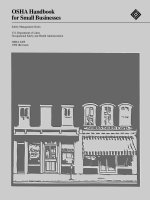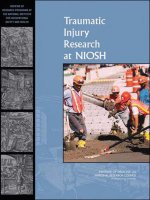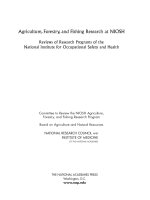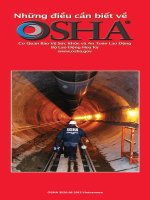Xử lý bệnh nhân an toàn: Thực hành chương trình Xử lý bệnh nhân an toàn của OSHA và NIOSH
Bạn đang xem bản rút gọn của tài liệu. Xem và tải ngay bản đầy đủ của tài liệu tại đây (1.43 MB, 51 trang )
Safe Patient Handling:
Recommended Best Practices
PRESENTED BY THE UNIVERSITY OF TEXAS-SCHOOL OF PUBLIC HEALTH
This material was produced under grant number SH-22316-SH-1 from the Occupational Safety and Health
Administration, U.S. Department of Labor. It does not necessarily reflect the views or policies of the U.S. Department
of Labor, nor does mention of trade names, commercial products, or organizations imply endorsement by the U.S.
Government.
Learning Objectives
By the end of this module participants should be able to:
• Describe the elements of OSHA and NIOSH’s Safe
Patient Handling Programs.
• Identify appropriate techniques and strategies for safe
patient handling practices.
• Describe how elements of this program can be
incorporated into the participant’s inpatient nursing
unit.
Background
• Nurses and Nurses’ Aides are at high risk for work-related
back pain
– Nurses’ aides at higher risk for work-related back pain
compared to nurses
– Perform more lifting, bending and twisting in their jobs
• Nurses, nurses’ aides and orderlies among those most
likely to lose time from work due to work-related back pain
– Aides and orderlies have higher lost workday injury
rates compared to nurses
References: Bureau Labor Statistics, 2005; Engkvist et al., 2000; Fuortes et al. 1994; Guo et al., 1995;
Videman et al., 1984
Mechanics of Patient Handling Tasks
• Patient transfers
– one-person (hug) vs. two-person (gait belt)
– bed-wheelchair, bed-commode, commode-chair
• Repositioning
– one-person vs. two-person
– hook method, draw sheet, lift under thigh, and
shoulder
• None of the techniques assessed sufficiently protect
patient handlers
• All tasks exceed spinal load limits recommended by
NIOSH (Marras et al. 1999)
Study Findings
Pompeii et al.
• Musculoskeletal Injuries Resulting From Patient Handling Tasks Among
Hospital Workers. American Journal of Industrial Medicine
Injury Claims Resulting from Patient Handling
Nurses and Nurses’ Aides (n = 630)
25%
20%
15%
10%
22%
20%
17%
13%
13%
10%
5%
5%
0%
1997-2003
What is “Best Practice” Patient Handling?
•
•
•
•
•
VA – Audrey Nelson
OSHA
NIOSH
AOHP
Washington State – OSHA
(copies are provided)
Elements of a ‘Best Practice’ Patient Handling
Program –VA (1)
• Ergonomic Assessment Protocol:
– Assess the hospital environment, examine injury
rates, identify high-risk units
• Patient Assessment Criteria
– Tools to help nurses evaluate patient characteristics
that affect decision making about equipment and
techniques for safe patient handling
• Algorithms for Patient Handling/Movement
– Standardized processes for making decisions about
the equipment and the number of staff necessary to
perform high-risk activities safely.
Elements of a ‘Best Practice’ Patient Handling
Program –VA (2)
• Selection of patient handling equipment (mechanical,
non-mechanical)
– Ensuring that the right equipment is available in sufficient
quantities, kept in convenient locations, and in operating
condition
• BIRNs-Back Injury Resource Nurses
– Peers selected for high-risk nursing units who are specially
trained in the identification of workplace hazards, in the criteria
for assessing safe patient handling and movement, and in the
use of algorithms. The role also includes onsite training and
evaluation of peers regarding the proper use of equipment
• “After Action Review”
– Knowledge the team has gained by performing a task in one
setting and how it is applied in a different setting
Elements of a ‘Best Practice’ Patient Handling
Program –VA (3)
• “No-Lift Policy” or “Minimal Manual Lift Policy"
– Establishes an agreement among staff members
that they will use the safest approach to handling
and moving patients
– Indicates support from management that safe
patient handling practices should be used
• Patient Assessment Criteria
– Tools to help nurses evaluate patient characteristics
that affect decision making about equipment and
techniques for safe patient handling
• Algorithms for Patient Handling/Movement
– Standardized processes for making decisions about
the equipment and the number of staff necessary to
perform high-risk activities safely.
• Selection of patient handling equipment
(mechanical, non-mechanical)
– Ensuring that the right equipment is available in sufficient
quantities, kept in convenient locations, and in operating
condition
Equipment at St. Luke’s
•
•
•
•
Gait Belt
Draw Sheet
Hoyer Lift
Slide Board
Draw Sheet
/>
Gait Belts









